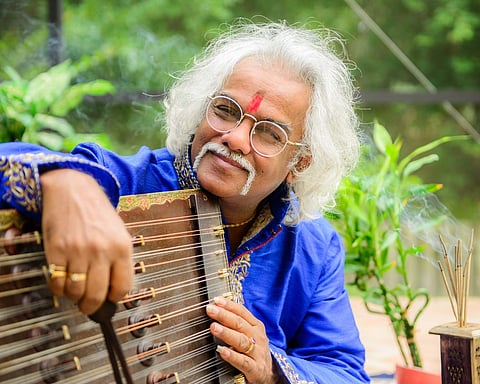Pandit Tarun Bhattacharya is paving new paths for enthusiasts of classical music
SANTOOR VIRTUOSO PANDIT Tarun Bhattacharya may have been a pioneer of music heritage for more than four decades. However, we’d only be giving him partial credit if we didn’t mention all that he is doing to blaze new paths for the newer generation. The artiste, whose gurukul is taking musical education everywhere from the towns of Howrah to Los Angeles, is forging new avenues in digital learning. He has a l s o b e e n responsible for some of the most significant moments in culture, be it his Grammy nomination, or his invention of the widely-used tuner named Mankas. And it was only recently that the coveted Sangeet Natak Akademi Award was conferred upon him—a long-overdue recognition. But the maestro tells us he is elated nevertheless. “I’m happy, that an award like this is always an achievement,” he tells us, with an affable grin.
The son of Pandit Rabi Bhattacharya, Tarun Bhattacharya began his classical education at the age of four, and famously received tutelage from none other than Pandit Ravi Shankar. “He has taught me so much… But, I must talk about how he taught me the crucial technical attributes of sitar and sarod, and helped me bring it to the realm of santoor. Krintans, for instance, is a technique of playing the sitar — Pandit Ravi Shankar taught me how to get that same sound in the santoor, and that led me to experiment with the sounds over the years,” he tells us. Bhattacharya also famously invented the mankas in 1982, which a fine tuner for the santoor, and is perhaps one of the most significant innovations in classical music. It is a small, winged, bird-shaped tuner with a hole. Moving the mankas along the strings brings a change in its tension and its pitch. “Santoor is originally known as the Shata Tantri Veena, because it is the instrument with a hundred strings, and it is a cumbersome job to tune each and every string. I came up with the mankas, to be used as a fine tuner. Especially when I’m on stage and my instrument goes out of tune — I can just tune my strings in a few seconds to achieve the right pitch. It has been incredibly helpful. Now of course, people all over the world use it, and my students, use it obviously,” says Bhattacharya, who has played in some of the most celebrated locations around the world, be it the Royal Albert Hall in London or the Palais des Beaux-Arts in Brussels, and has set up his first school in Los Angeles just a few weeks back.
Bhattacharya’s gurukul Santoor Ashram, of course, has made way for young learners from under-privileged backgrounds to acquire teachings in classical music, free of cost. “I just opened up the first Santoor Ashram in LA and recently got the 501(c)(3) status, which is a non-profit status. The other most prominent outlet in Domjur, Howrah, and of course, we have branches across North, South and Central Kolkata. In LA, we are doing a lot to promote Indian music among American children, because I do believe this music can bring out the best in us, and actually make us better human beings,” we are told. The maestro also acknowledges the newer approaches that are working towards making classical music more accessible to the millennial generation, specifically social media. “We have already started making the most of technology to reach out to people across the globe. I have my WhatsApp video classes, and there are so many people from the US, Europe, specifically Holland and Spain, and other parts of the world who reach out and take lessons from me,” adds the maestro

